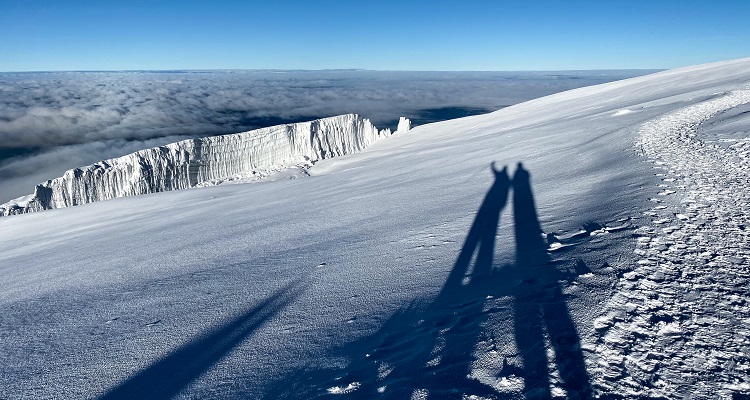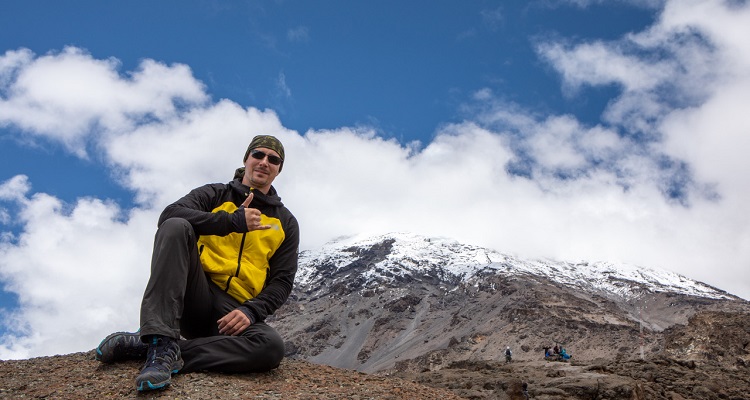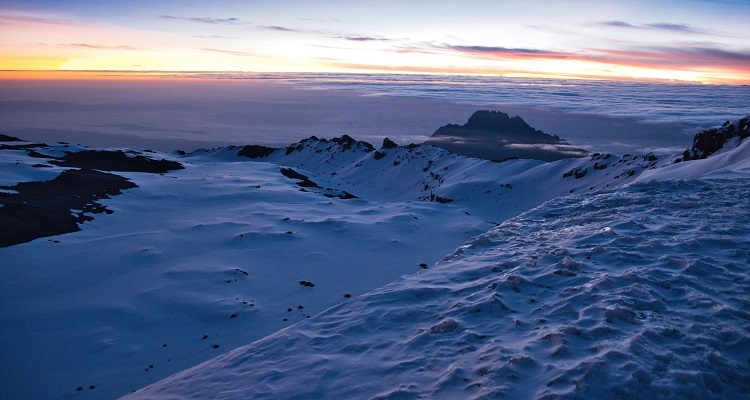6 Days Umbwe Route - Mount Kilimanjaro Trekking

Description
Umbwe Route: Is the most scenic but is recommended only for experienced climbers. It starts with a quick ascend, so it provides very little time for acclimatization. It is located at the southern part of the mountain and referred to whisky route because of its steep ascend. It can be climbed in 6 days. To get to Umbwe gate 1600m you have to drive to Machame gate first to get your entry permit, and then you have to drive about 30km back to Moshi and take a diversion left to Umbwe village. 6 Days
Compared to the other routes it does not provide enough time for acclimatization because from beginning it is very steep.
ITINERARY
-
- Arrival
- DAY 1: Umbwe Gate (1600M) to Umbwe Cave (2850M)
Distance: 11 Kilometers.
Time: 6 Hours walking.
Zone: Rain forest. - DAY 2: Umbwe Cave (2850M) to Baranco Hut (3900M)
Distance: 5 Kilometers.
Time: 4 Hours walking.
Zone: Moorland. - DAY 3: Barranco Hut (3900M) to Karanga Hut (3995M)
Distance: 6 Kilometers.
Time: 4 Hours walking.
Zone: Alpine desert. - DAY 4: Karanga Hut (3995M) to Barafu Hut (4673M)
Distance: 4 Kilometers.
Time: 3 Hours walking.
Zone: Alpine desert. - DAY 5: Ascend to the Summit at Uhuru Peak (5895M)
Distance: 5 Kilometers.
Time: 5 Hours walking.
Zone:Alpine/Glacial zone. - DAY 6: Mweka Camp to Moshi
Upon arrival at Kilimanjaro International Airport, you will be met and transferred for overnight accommodation at Hotel B&B. Your head guide will meet you for your briefing, gear check and arrange for you equipments .
On day 1 you will hike from Umbwe gate (1600m) to Umbwe camp. You will pass through dense rain forest. You will be able to see Black and White Colubus as well as Blue Monkeys and some endemic flowers like Impatiens Kilimanjari.
From Umbwe camp to Baranco camp it is a very steep climb. The distance is 6km which will take 4-5 hours of hiking and you will be in the moorland zone. The trail becomes less steep as you get closer to Baranco camp. At Baranco camp you will meet climbers from Machame, Lemosho and Londorossi routes.
The hike from Umbwe to Baranco offers a nice view of your ultimate destination, Kibo peak, and also numerous rift valleys on the way and the forest you crossed on day 1.From Baranco camp to Karanga camp it takes 2 – 3 hours and distance is 5km and you will cross Breakfast or Baranco Wall, which is 300m high. The peak of the wall is at 4200m. This part is challenging because the trail is narrow and the number of hikers, porters and guides is large. In some parts you have to use your hands for climbing. You will cross the famous places called Kissing Rock. Shorty before Karanga Camp you will cross the Karanga Valley at 3930m which is the last point where porters can fetch water.
It will only take 2 to 3 hours and the covered distance is 4km from Karanga to Barafu Camp. It is not steep but to acclimatize you have to walk pole pole (slowly). You will be in the alpine desert and at the left side you can see the Kibo Peak and few meters before Barafu you will find Sedimentary rocks. There is no water at the camp, so our team will carry water from Karanga Valley.
Summit Night:
The climb from Barafu camp to Uhuru point is 5km, which will take 6 to 7 hours and it is steep. The way is a zigzag path. The starting time is around midnight. It is a challenging night and before you reach to Uhuru point you will cross the Stella Point (5756m) at the crater rim and join with the people from Marangu and Rongai routes. From Stella Point to Uhuru Point (5895m) is one hour of walking and mostly flat. After making it to Uhuru Point you can make pictures and you will return via the same route to Barafu Camp for a bit of sleep and brunch after wake up. Afterwards the descend down will start via Mweka Route.The descend via Mweka route starts at Barafu camp to Millennium Camp 3797m. The way is steep, and it just takes only 2-3 hours to cover the 4km to Millennium Camp. You will pass from the alpine desert to the moorland zone.
From Millennium Camp to Mweka camp 3100m is also a steep walk which takes 2 – 3 hours for 3.5km. You will cross the moorland to the forest zone and on the way you will see Protea Kilimandscharica and Red Hot Poker and various other species of flowers and plants.After breakfast, you will continue the descent down to the Mweka Park Gate to receive your summit certificates. At lower elevations, it can be wet and muddy. Gaiters and trekking poles will help. Shorts and t-shirts will probably be plenty to wear (keep rain gear and warmer clothing handy). From the gate you will sign out in Kilimanjaro national park log book and your guide will collect your certificate for those who reached the summit and let you enjoy your lunch before get to our minibus and drive to your hotel in Moshi for hot shower and beer.
Incudes & Excludes, Map & Trekking Equipments
-
Price includes
>>Private transport to & from Kilimanjaro International Airport to your accommodations in Moshi.
>>2 nights of accommodation in Moshi.
>>Transportation to & from the Kilimanjaro gate
>>Park entry fees,
>>Camping fees.
>>Team Kilimanjaro Rescue fees.
>>18% VAT on tour fees & services
>>4 Season mountain tents
>>Double layered Sleeping Mats
>>Friendly and professional mountain guides, cook and porters.
>>3 hot meals daily while on the mountain.
>>Enough treated & filtered drinking water throughout the trek.
>>Hot water for washing.
>>Fair wages for the mountain crew as approved by the Kilimanjaro National Park Authority (KINAPA), Kilimanjaro Association of Tour Operators (KIATO)
>>Government taxes
>>Portable oxygen tanks & ox meter
>>Emergency first-aid kit.
Price Exclude
>>Lunches, dinners and drinks at your hotel before and after climb.
>>Travel insurance
>>Flights.
>>Laundry (Available at hotel).
>>Personal items and toiletries.
>>Tips for guides, porters and cook .
Technical Clothing:
1 - Waterproof Jacket, breathable with hood - $151 - Insulated Jacket, synthetic or down - $15
1 - Soft Jacket, fleece or soft-shell - $10
2 - Long Sleeve Shirt, light-weight, moisture-wicking fabric - $10
1 - Short Sleeve Shirt, light-weight, moisture-wicking fabric - $10
1 - Waterproof Pants, breathable (side zipper recommended) - $ 5
2 - Hiking Pants - $10
1 - Fleece Pants - $5
1 - Shorts (optional) - $5
1 - Long Underwear, moisture-wicking fabric - $5
3 - Underwear, moisture-wicking fabric recommended - $5
2 - Sport Bra (women)
Equipment
1 - Sleeping Bag, warm, four seasons - $251 - Camp Pillow, inflatable (optional)
1 - Trekking Poles, collapsible (highly recommended) - $10
1 - Head Lamp, with extra batteries - $20
1 - Duffel Bag, 50-90L capacity, for porters to carry your equipment - $15
1 - Daypack, 30-35L capacity, for you to carry your personal gear - $15
Paperwork
Passport – Valid more than 6 months.Visa (applied online but also available at JRO)
Immunization Papers
Insurance Document (That covers 6000m recommended) *
Accessories
1 - Sunglasses or Goggles1 - Backpack Cover, waterproof (optional)
1 - Water Bottle (Nalgene, 32 oz.)
1 - Water Bladder (Camelbak type, 3 liters)
1 - Towel, lightweight, quick-dry (optional)
1 - Pee Bottle, to avoid leaving room/tent at night (recommended)
Head Wear
1 - Brimmed Hat, for sun protection - $51 - Knit Hat, for warmth - $ 5
1 - Balaclava or Buff, for face coverage (optional) - $5
Hand Wear
1 - Gloves, warm (waterproof recommended) - $51 - Gloves, thin - $ 5
Footwear
1 - Hiking Boots, warm, waterproof, broken-in - $201 - Gym Shoes, to wear at camp (optional)
3 - Socks, wool or synthetic - $5
1 - Gaiters, waterproof (optional) - $5
Other Important things:
ToiletriesPrescriptions
Sunscreen
Lip Balm
Insect Repellent, containing DEET
First Aid Kit
Hand Sanitizer
Toilet Paper
Wet Wipes (recommended)
Snacks, light-weight, high calorie, high energy (optional)
Electrolytes, powder or tablets (optional)
Camera, with extra batteries (optional)
Other Trekking Information
So, you've decided to take on the challenge of tackling Africa's highest peak? Next, you need to think about the best time to climb Kilimanjaro, in terms of weather, trekking conditions and popularity. Although it's technically possible to trek Tanzania's Mount Kilimanjaro year round, there are certain months which are characterised by colder weather, more rain and potentially lots of snow on the summit. We generally advise that the best time to climb Kilimanjaro is during the warmest and driest times of year, from December to mid-March and mid-June to the end of October.
What is altitude sickness?
Also called Acute Mountain Sickness (AMS), it is an illness that can affect travellers at high altitudes, usually above 2400m (8000 feet) such as on Mount Kilimanjaro. Altitude sickness is the name given to the physiological and symptomatic reactions of the body to the low oxygen pressure (‘thinner’ air) that occurs at high altitude. When oxygen pressure falls, the body reacts by increasing breathing and heart rate and starts to produce more red blood cells. More red blood cells mean more vehicles to carry oxygen in the blood. The body also increases production of an enzyme that causes the release of oxygen from haemoglobin to the body tissues. Causes of altitude sicknessAMS is caused by reduced air pressure and lower oxygen levels at high altitudes. The faster you climb, the more likely you will get AMS. It is not only the height that matters so much, it is the rate of ascent.
You are at higher risk for AMS if you live near sea level and have had the illness before. Others at risk are those with diseases of the heart/lungs such as chronic bronchitis and asthma, people who are anaemic and those with a history of thromboses. Older people and children are also more susceptible to AMS. Symptoms of altitude sickness
Your symptoms will depend on the rate of your climb and how hard you push yourself. Symptoms usually start 12 – 24 hours after arrival at altitude and can affect the nervous system, lungs, muscles and heart. It is important to remember that reducing the symptoms is not curing the problem. The symptoms of altitude illness are similar to those of a hangover. Initially it starts with a headache, lack of appetite, tiredness and feeling off balance. Many hikers find it difficult to sleep. Then nausea sets in and vomiting starts. Headaches are getting more intense. If you continue, conditions might deteriorate. Sometimes the lack of oxygen can cause the leaking of fluid into the brain and lungs. High Altitude Cerebral Edema (HACE) and High Altitude Pulmonary Edema (HAPE) can develop. Our guides are very experienced with AMS. They will be monitoring all symptoms and will take a safe and well-informed decision on whether to proceed or descend. Most often symptoms will be swiftly relieved with decreasing altitude.
More severe acute mountain sickness includes: Blue skin and lips (cyanosis) and grey or pale complexion
Tight chest
Cough and coughing up blood
Confusion, decreased consciousness or withdrawal from social interaction
Not being able to walk in a straight line or unable to walk.
Prevention of altitude sickness
The slower you go, the better you will acclimatise and the higher you are likely to go without experiencing many symptoms. Recognise early symptoms of AMS and if symptoms increase, descend. Your guide will help you take a decision. The only cure is either acclimatisation or descent.Walk slowly, relax and enjoy.
Drink plenty of fluids while climbing, at least 3 to 4 liters of water per day.
Avoid alcohol when ascending
Talk to your doctor before you attempt to climb Kilimanjaro and ask about the correct preparation, first-aid medication and treatment options for AMS. If you are anaemic, ask your doctor for an iron supplement.
Colds
The risk of altitude sickness will be increased if you are already suffering from respiratory tract infection such as a cold. If you have the flu, do not travel until you are fully recovered. Both colds and the flu are caused by viruses and anti-biotics will not be effective as it is used against bacterial infections.Acute upper respiratory tract infections include pharyngitis/tonsillitis and laryngitis. Complications may lead to sinusitis, ear infection and sometimes bronchitis which can all be exacerbated by high altitude.
Some research has shown that restrained exercise might not change the severity and duration of the illness, but the intensity of a Kilimanjaro hike will jeopardise your recovery. Getting plenty of sleep is advised as sleep deprivation is associated with increased receptiveness to infection.
- Duration6 Days, 5 night
- Group SizePrice(Us $)
- 1 Person $ 2600
- 2-6 People$ 2500
- 7-12 People$ 2300
- 13-20 People$ 2100


